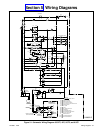TP-5695 12/93 Installation 6-1
Section 6. Installation
Introduction
Use this section as a guide when installing the Marine
generator set, then refer to Section 2. Operation for
specific service instructions. Reliable and safe
generator set operation depends largely upon proper
installation. Remember that the generator set will
probably be the craft’s sole source of electrical power.
When installing a marine generator set, it is
recommended that the installation comply with all
applicable Regulations and Standards. See Reference
Material for documents issued by governing agencies.
Information presented here should be followed in
planning and making installations. Specifications given
should be used only in initial planning. Use current
dimension drawings and wiring diagrams.
NOTE
A wood block is located under some generator set end
brackets to prevent damage during shipment. For the
same reason, metal brackets are used to attach some
generator sets to their wood shipping bases. These
items MUST be removed prior to installation in order to
provide adequate vibration clearance during generator
set operation. Check that all packing material, literature,
and loose accessories are removed from generator set
prior to operation.
Generator Selection and
Wattage Requirements
Total wattage requirements (lights, motors, appliances)
must be considered when selecting a generator set, or
when sizing wattage usage where available space and
construction limit the size of the generator set. The
4-lead reconnectable generator set can be connected
for 120 volt or 120/240 volt 60 Hz (110 volt or 110/220
volt 50 Hz), see Section 5. Wiring Diagrams.
NOTE
When a generator set is reconnected to produce a
voltage different than nameplate voltage, notice should
be placed on the unit indicating this change. Decals (part
number 246242) for this purpose are available from
authorized Kohler dealers/distributors.
Lighting Load
The lighting load is usually easiest to calculate. In most
cases, simply add the wattage of each lamp to be
operated off the generator set. Note that in many
applications, not all of the lights or lamps are in the
generator set AC circuit—some are DC powered by the
12-volt battery in the craft. Make sure the total includes
only lights actually on the generator set AC circuit.
Motor Loads
When figuring generator set capacity requirements that
include electric motors, do not overlook the high current
demanded by the motors during start-up. The in-rush or
starting current is typically 2--3 times higher than that
required when the motor reaches normal operating
speed. Reserve capacity must be allowed for in-rush
demands plus other loads which could be on the line as
the electric motor starts.
Air conditioning units are perhaps the most common
type of motor load for generator sets in marine
applications. The starting characteristics of the different
varieties of air conditioners vary greatly—one particular
12,000 Btu unit has, for example, lower starting
requirements than a 10,000 Btu unit of another make.
When only one unit is involved, there is usually no
starting problem, provided the lighting and appliance
load is not too high when the unit is started.
Simultaneous starting of two air conditioning units,
however, can present problems if the capacity is
marginal. Because of the variation in starting
characteristics of the various makes of air conditioners,
no definite statements are made in this publication
regarding multiple-motor starting capabilities of the
marine generator set covered. Delayed starting or use
of easy-starting devices on air conditioner units should
be considered whenever simultaneous starting of more
than one motor is involved.
The starting and running requirements of some motor
loads common to marine applications are listed in
Figure 6-1; use this as a guide when selecting generator
set capacity requirements involving motor loads. See
Figure 6-2 for generator set capabilities regarding air
conditioners.


















